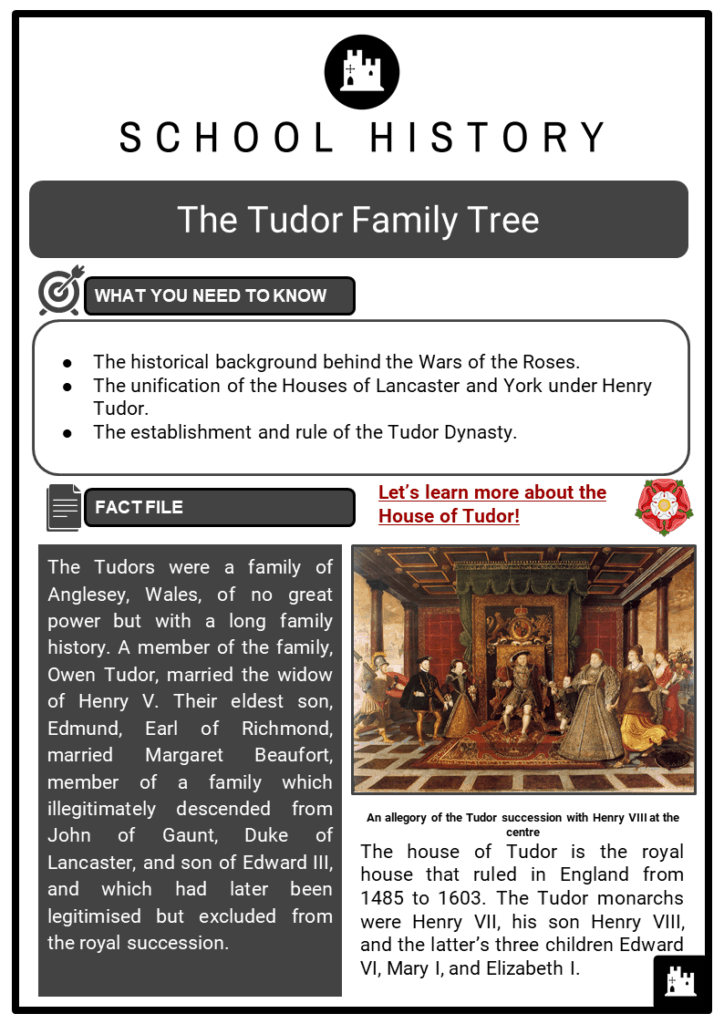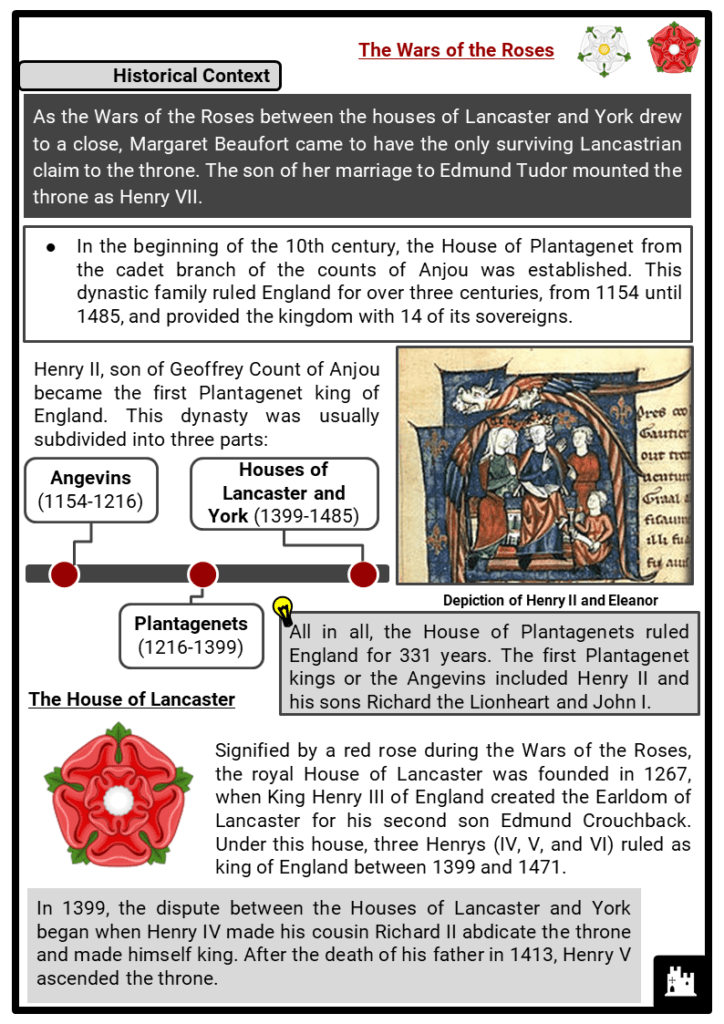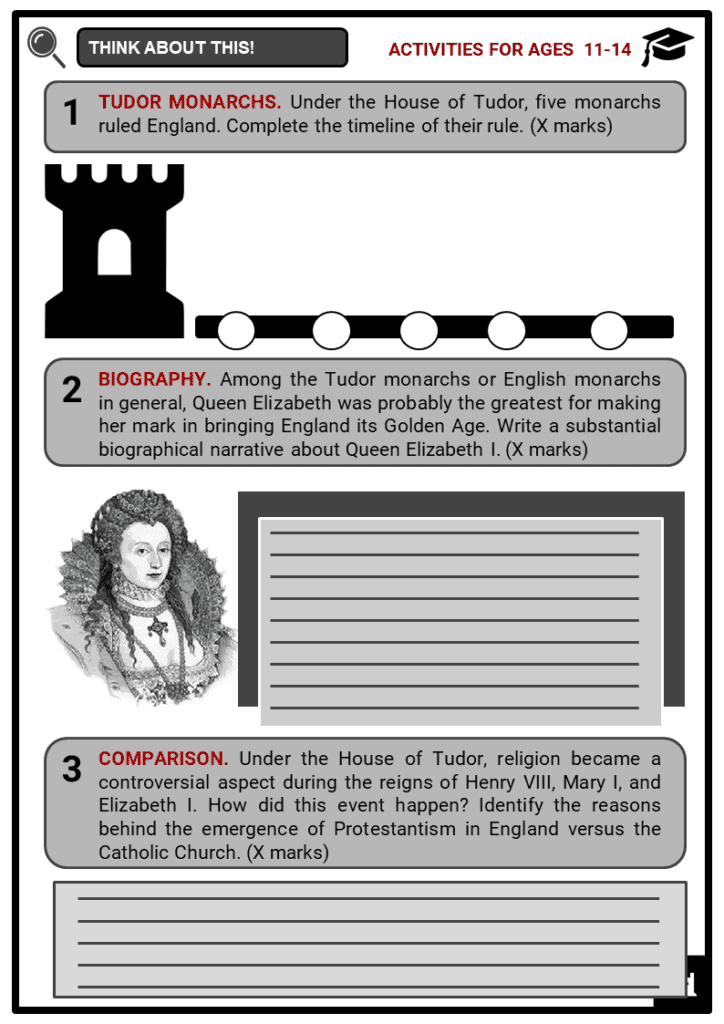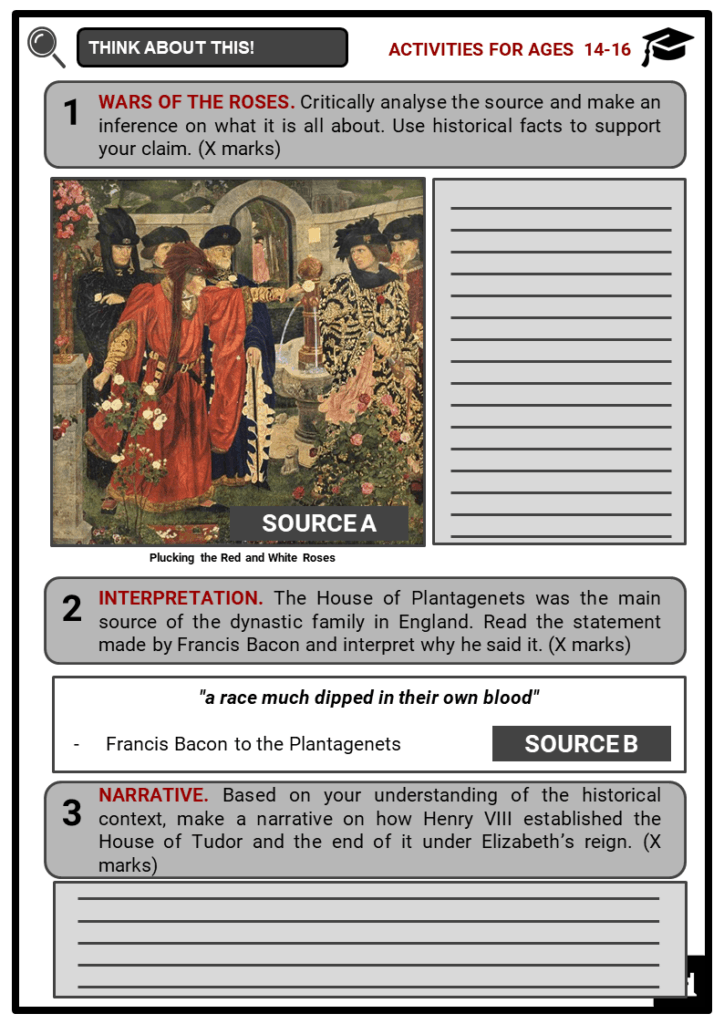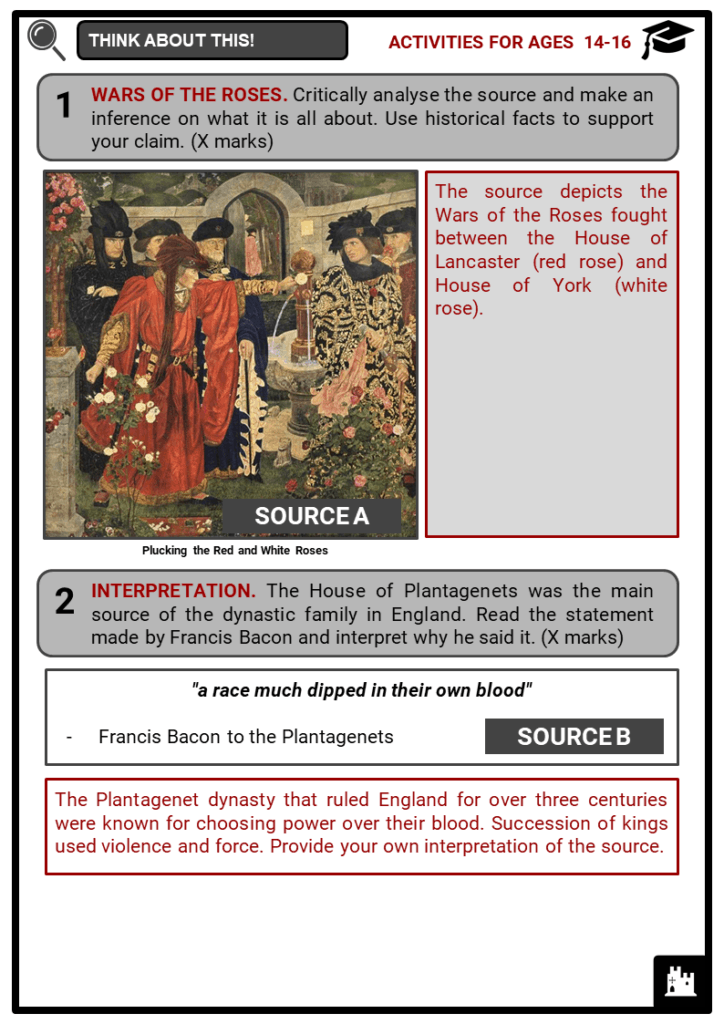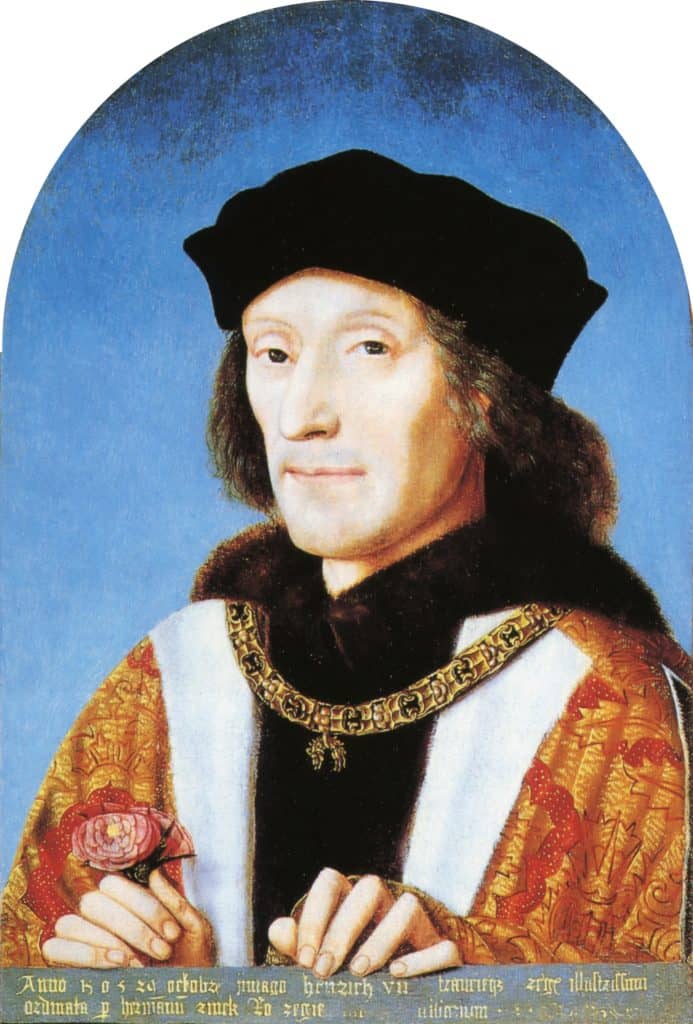Download The Tudor Family Tree Worksheets
Do you want to save dozens of hours in time? Get your evenings and weekends back? Be able to teach The Tudor Family Tree to your students?
Our worksheet bundle includes a fact file and printable worksheets and student activities. Perfect for both the classroom and homeschooling!
Table of Contents
Add a header to begin generating the table of contents
Summary
Key Facts And Information
Let’s learn more about the House of Tudor!
- The Tudors were a family of Anglesey, Wales, of no great power but with a long family history. A member of the family, Owen Tudor, married the widow of Henry V. Their eldest son, Edmund, Earl of Richmond, married Margaret Beaufort, member of a family which illegitimately descended from John of Gaunt, Duke of Lancaster, and son of Edward III, and which had later been legitimised but excluded from the royal succession.
- The house of Tudor is the royal house that ruled in England from 1485 to 1603. The Tudor monarchs were Henry VII, his son Henry VIII, and the latter’s three children Edward VI, Mary I, and Elizabeth I.
The Wars of the Roses
- As the Wars of the Roses between the houses of Lancaster and York drew to a close, Margaret Beaufort came to have the only surviving Lancastrian claim to the throne. The son of her marriage to Edmund Tudor mounted the throne as Henry VII.
- In the beginning of the 10th century, the House of Plantagenet from the cadet branch of the counts of Anjou was established. This dynastic family ruled England for over three centuries, from 1154 until 1485, and provided the kingdom with 14 of its sovereigns.
- Henry II, son of Geoffrey Count of Anjou became the first Plantagenet king of England. This dynasty was usually subdivided into three parts:
- All in all, the House of Plantagenets ruled England for 331 years. The first Plantagenet kings or the Angevins included Henry II and his sons Richard the Lionheart and John I.
- The House of Lancaster
- Signified by a red rose during the Wars of the Roses, the royal House of Lancaster was founded in 1267, when King Henry III of England created the Earldom of Lancaster for his second son Edmund Crouchback. Under this house, three Henrys (IV, V, and VI) ruled as king of England between 1399 and 1471.
- In 1399, the dispute between the Houses of Lancaster and York began when Henry IV made his cousin Richard II abdicate the throne and made himself king. After the death of his father in 1413, Henry V ascended the throne.
- The House of York
- Founded by Edmund Langley, King Edward III’s fifth son, the royal House of York was the younger branch of the Plantagenet House. It provided England with three kings - Edward IV, Edward V, and Richard III before finally handing England to the Tudor Dynasty.
- After defeating the Lancastrians in a number of battles, Edward IV became the first Yorkist king of England in 1461. Overthrowing Lancastrian king, Henry VI, Edward became king until 1470. For a year, Henry VI was able to restore his kingship. By 1471, Edward IV became king again, who was succeeded by his elder son, Edward V. After two months of being king, he was deposed by his own uncle, Richard III. For two years, Richard III ruled as king of England until his death at the Battle of Bosworth against future Tudor King, Henry VII.
- Causes of the conflict
- The increasing fear of kings and their heirs being murdered which was initiated in 1399 CE by Henry Bolingbroke (crowned as Henry IV, the first Lancastrian king).
- Incapacity of Henry VI to rule England, including discontent over local governance and economic stagnation.
- Conflict and disagreement among members of the nobility regarding the war with France.
- Increasing power of landowners who built their own private armies.
- Richard, Duke of York’s ambition to become king of England.
- The goal of Henry Tudor to restore Lancastrian rule of England.
Unification of the Roses by Henry Tudor
- Henry VII was the first Tudor king of England. He was born in Pembroke Castle in Wales, on January 28, 1457. Through his mother he could trace his descent from John of Gaunt, son of Edward III. In 1471, he was taken to Brittany by his uncle Jasper Tudor to protect him from the victorious Yorkists led by Edward IV. Henry’s attempted invasion of England in 1483, made to enforce his claim to the throne, failed, but in 1485, he defeated and killed Richard III at the battle of Bosworth.
- After his coronation as the first king of the house of Tudor, he married Elizabeth, daughter of Edward IV, and so attracted the loyalty of many Yorkists. Though he had to meet the revolts of Lambert Simnel and Perkin Warbeck, his reign proved successful in many ways.
- He brought the surviving nobles to heel, partly by vigorous use of the Star Chamber; he established order and security and so obtained the support of the rising middle and merchant class.
- He married his daughter Margaret to James IV, king of Scotland, and his son to Catherine of Aragon, thereby gaining increased recognition of his new dynasty; he kept peace and piled up a large financial reserve. Interested in the new learning, astute in diplomacy, he was not too popular as a monarch. He died in Richmond on April 21, 1509.
The royal House of Tudor
- The emergence of the Tudor Dynasty marked the end of the war between the royal houses of Lancaster and York.
Tudor Monarchs of England
- Henry VIII (1509 - 1547)
- Born in 1491 at Greenwich, Henry was the second son of Henry VII. The death of his eldest son, Arthur in 1502 made Henry the heir to the English throne which he ascended in 1509. Soon after his ascension, he married Catherine of Aragon, his brother’s widow. Between 1510-1514, Henry was involved in the war between France and Spain; and between 1512-1513, he took part in the war between France and Scotland.
- The war gave Henry his first great minister, Cardinal Thomas Wolsey, who, starting in 1515, held all the strings of power in state and church. Henry never lost ultimate control of affairs, but he was content to follow Wolsey’s lead.
-
- Henry preferred hunting, games, masks, mistresses, and music to the painful drudgery of government. Wolseys’ policy led through the triumph of a European peace embodied in the Treaty of London (1518). Meanwhile, by 1527, Henry was determined to get rid of his wife. His chief motives were: a passionate attachment to one of the court ladies, Anne Boleyn; and his fear for the succession.
- Henry was seeking a declaration of nullity: Wolsey failed to secure papal consent to the king’s demands and, in 1529, the Cardinal completely lost his power. Thomas Cromwell ensured the king his success by throwing off the pope’s authority altogether and creating a national Church of England under the supreme leadership of the king himself.
- Henry divorced from Catherine. Such resolution caused the dissolution of monasteries, and promoted the rise of Protestantism. However, difficulties over what was the true faith ended with the adoption of the orthodox Act of Six Articles (1539) and a careful holding of the balance between extreme factions after 1540.
- Meanwhile, Anne Boleyn, who had managed to produce only a daughter, had been executed in May 1536, on charges of adultery. In 1536, Henry chose Jane Seymour, who died within a year while providing the desired male heir (future King Edward VI).
- In January 1540, Thomas Cromwell’s Protestant policy involved the king’s marriage to Anne of Cleves, whom Henry disliked from the start and soon divorced.
- In August 1540, Henry made a love match with Katherine Howard, executed in 1542 for proven adultery.
- Finally in 1543, he settled for a more placid consort, Catherine Parr. By this time the vigour of Henry VIII’s person and reign was declining. The king died on January 28, 1547.
- Edward VI (1547 - 1553)
- The only son of Henry VIII, Edward VI succeeded his father as king of England and Ireland in 1547. He was Henry’s son to his third wife Jane Seymour who died giving birth to him. Due to Edward’s frail health and young age, he played little part in governing England.
-
- The power was in the hands first of his maternal uncle, Edward Seymour, Duke of Somerset, and then of John Dudley, Duke of Northumberland.
- Under their rule, with Edward’s complete approval, Protestantism was established in England, and the first English prayer book and forty-two articles of the Church of England were published.
- Edward’s will, made under Dudley’s domination, attempted to prevent the accession of Henry VIII’s daughters, Mary and Elizabeth, and to establish the claim of Lady Jane Grey, great-granddaughter of Henry VII. Edward died of tuberculosis at Greenwich on July 6, 1553.
- Mary I (1553 - 1558)
- Nicknamed as ’Bloody Mary’, Mary was the daughter of Henry VIII and Catherine of Aragon. As a child, she received a thorough education in Classic and modern languages. In 1526, it was proposed that she should marry the French king Francis I. In the course of discussion, the question of the legality of her mother’s marriage and, therefore, of her legitimacy was raised. The final result was the annulment in 1533 of Catherine’s marriage and the separation of mother and daughter.
-
- With the death of her mother, and the execution of Anne Boleyn, Mary’s situation was much improved. She made formal submissions to her father’s views and for the rest of his reign, had a household suited to her rank.
- When Henry died in 1547, she was placed by his will next in succession to the throne after her brother Edward VI and his children. Though she had her difficulties under the Protestant government of Edward VI, she was not badly treated, and in 1553 succeeded him as the monarch of England, having defeated the attempt of the Duke of Northumberland to place Lady Jane Grey on the throne.
- As Queen of England, people sympathised with her and she was popular. Her restoration of the papal supremacy and the Roman Catholic faith diminished that popularity. Her marriage with Philip II of Spain, which incited Sir Thomas Wyatt’s rebellion, was much disliked and the severity with which she persecuted the Protestant minority aroused great discontent.
- In 1557, to aid Spain, she involved England in a war with France, and her unpopularity was much increased by its failure and the capture of Calais, England’s last possession of the Continent. She died in London on November 17, 1558. Her policy in ruins at home and abroad, her reign was an utter failure.
- Elizabeth I (1558 - 1603)
- Born on September 7, 1553, Elizabeth was the second daughter of Henry VIII. Her mother, Anne Boleyn, was the king’s second wife. In order to marry Anne, the king had to divorce Catherine by breaking with the papacy. Elizabeth may thus be regarded as the child of the English Reformation, and this role shaped her whole future. As a child, Elizabeth was educated by humanist scholar Roger Ascham who regarded her as a woman of intelligence.
-
- The reign of her half-sister Mary Tudor threatened her life. Many Protestants relied on Elizabeth which later caused her arrest and exile at the Tower of London.
- She was not executed, but only because of the lack of conclusive evidence against her. Elizabeth succeeded to the throne on November 17, 1558. Her accession was enthusiastically welcomed, especially by the citizens of London and by all Protestants.
- The Queen proved ready to sever the English church once more from Rome and the papacy.
- Statesmen and Parliament were gravely concerned with securing the Protestant future of the country, since Elizabeth was the last of the Tudors. They pressed her to marry, but the choice of a husband was so difficult and perilous that marriage proved impracticable.
- Through both choice and politics, she remained England’s Virgin Queen.
- In 1561, after the death of her husband Francis II of France, Queen Mary of Scots returned to her native land, and the personal relations of the two queens started their complicated, controversial history.
- When Mary abdicated her throne of Scotland, she attempted to find refuge in England. However, she was locked in the Tower of London for almost twenty years on the accusation of having attempted to murder Elizabeth. Queen Mary was executed.
- As a result of Mary’s death, Catholics raged war against England which led to the defeat of the legendary Spanish Armada.
- On March 24, 1603, Queen Elizabeth I died heirless, thus made her the last of the Tudor monarchs of England.
Image sources:
[1.] https://upload.wikimedia.org/wikipedia/commons/e/e9/King_Henry_VII.jpg
[2.] https://upload.wikimedia.org/wikipedia/commons/c/c6/Henry_VIII_National_Maritime_Museum.jpg
[3.] https://upload.wikimedia.org/wikipedia/commons/4/4f/Edward_VI_of_England_c._1546.jpg
[5.] https://upload.wikimedia.org/wikipedia/commons/c/cf/Elizabeth_I_Rainbow_Portrait.jpg

